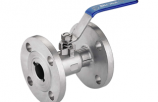Key Differences Between Ball Valves and Angle Valves
 secureluokai
secureluokai
 August 24, 2025
August 24, 2025

Ball valves and angle valves are two common types of valves in plumbing systems, with significant differences in structural design, functional positioning, and application scenarios. Their specific distinctions can be detailedly compared from the following five dimensions:
### 1. Structural Design: Differences in Core Shape and Internal Construction
– **Ball Valve**: Its overall structure features a “circular” core design. Inside the valve, there is a spherical valve core with a circular through-hole. The valve core is connected to the external circular handle via a valve stem. When the handle rotates, the valve core rotates accordingly, and the on-off state is achieved by aligning or misaligning the through-hole with the pipeline. Most valve bodies adopt a straight-through design, allowing fluid to flow in a straight line, with a smooth internal flow channel and no obvious corners.
– **Angle Valve**: Named for its “90-degree corner” structure, the valve body itself has a distinct right-angle bend (usually the water inlet and outlet intersect vertically), and its appearance is more similar to an “L” shape or a “right angle”. The internal valve core is mostly a ceramic disc structure. By rotating the valve stem to drive the relative movement of the ceramic discs, the opening size of the flow channel is adjusted, thereby controlling the water flow.
### 2. Functional Uses: Different Positioning and Adaptation to Scenarios
– **Ball Valve**: Its core function is to “efficiently control the on-off of water flow” and also has a certain ability to regulate flow. It is especially suitable for scenarios requiring quick on-off and large-flow transmission. Common applications include:
– The main switch of the household main water pipe, facilitating overall water cut-off for maintenance;
– Water inlet/outlet control of large water-consuming equipment such as water heaters and wall-hung boilers;
– Systems with high requirements for on-off efficiency, such as industrial pipelines and heating pipelines.
– **Angle Valve**: Its core function is “connection and branching”, while also assisting in the fine adjustment and shut-off of local water flow. It is mainly used for the transitional connection between pipelines and terminal equipment. Common applications include:
– Connecting the toilet water tank to the wall water pipe, making it convenient to close the toilet water circuit independently for maintenance;
– Connecting faucets, shower heads to wall pipelines, playing a role in transitional steering and local water control;
– Connecting the water inlet end of small household appliances such as washing machines and dishwashers, facilitating independent water cut-off for the equipment.
### 3. Control Method: Differences in Operation Angle and Adjustment Logic
– **Ball Valve**: It adopts “90-degree rotation control” with a simple and direct operation logic. Rotating the handle by 90 degrees (from “parallel to the pipeline” to “perpendicular to the pipeline”) can complete “full opening” or “full closing”. Some models can fine-tune the flow between 0-90 degrees, but the adjustment accuracy is low, making it more suitable for quick switching between “on/off” states.
– **Angle Valve**: It adopts “180-degree rotation adjustment” with a larger handle rotation range (usually rotating 180 degrees from the “closed position” to the “full open position”). Through the progressive opening and closing of the valve core, it achieves fine adjustment of water flow. It can not only fully shut off the water but also accurately control the water output (such as adjusting the water flow intensity of a faucet), with better adjustment flexibility than ball valves.
### 4. Price Cost: Price Difference Caused by Manufacturing Process and Materials
– **Ball Valve**: Due to the higher processing accuracy required for the internal valve core (sphere) (to ensure tight fit between the sphere and the sealing ring), and some models using higher-specification materials such as copper and stainless steel to enhance pressure resistance and sealing performance, the manufacturing process is more complex. Therefore, the cost is relatively higher, and the market price is usually 20%-50% higher than that of angle valves of the same specification.
– **Angle Valve**: Its structure is relatively simple, the processing difficulty of the valve core (ceramic disc) is lower, and the valve body materials are mostly brass or alloy. The manufacturing cost is lower, and the price is more affordable, making it suitable for batch use in the connection scenarios of household terminal equipment.
### 5. Sealing Performance: Sealing Effect Determined by Design Focus
– **Ball Valve**: Sealing performance is one of its core advantages. The sealing ring (mostly made of rubber or polytetrafluoroethylene) between the spherical valve core and the valve body fits tightly. In the fully open or fully closed state, it can effectively block fluid leakage, making it especially suitable for transporting media with high sealing requirements such as tap water and natural gas, with a low leakage probability after long-term use.
– **Angle Valve**: Its sealing performance is relatively weaker than that of ball valves. The main reason is that the sealing surface of the ceramic disc valve core is small, and after long-term frequent adjustment, the ceramic disc is prone to wear, which may lead to slight leakage. However, its advantage lies in “adjustment performance” — through the fine cooperation of ceramic discs, it can control the water flow more stably, making it suitable for scenarios that require flow adjustment but do not have extreme requirements for long-term sealing (such as the front end of a faucet).




